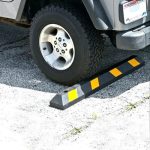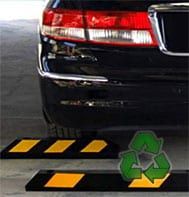
In the vast and intricate network of urban infrastructure, certain elements may escape our notice yet play a critical role in maintaining the efficiency, safety, and aesthetics of our cities. Among these unsung heroes of urban planning are parking blocks. These simple, often unnoticed barriers are far more versatile and crucial than they might appear at first glance.
Parking blocks, or parking stops, are primarily associated with their function in parking lots, ensuring orderly parking and safeguarding pedestrians. But their utility goes far beyond this conventional use. In an era where urban spaces are becoming more congested, and planners strive to create more sustainable, livable cities, parking blocks have emerged as multifunctional tools.
These concrete, rubber, or plastic barriers do much more than just demarcate parking spaces. They act as subtle guides and protectors, channeling both vehicular and pedestrian traffic, shielding vulnerable areas, and even contributing to environmental protection. Parking blocks have thus evolved from mere vehicular stops to essential components of modern city landscapes.
But what exactly are parking blocks, and why have they become so essential in contemporary urban planning? How are they utilized in innovative ways to address the multifaceted challenges of modern cities? And what does the future hold for this seemingly mundane yet incredibly versatile tool?
In this comprehensive guide, we will explore the varied uses of parking blocks, including their role in establishing multiple parking slots, sealing bike lanes, protecting grass and trees, and redirecting downhill rainwater. We’ll also delve into the materials and design considerations, best practices for installation and maintenance, and emerging trends in sustainable and smart urban solutions.
Join us as we uncover the hidden importance of parking blocks, revealing how they reflect broader themes of innovation, adaptability, and sustainability that are shaping the future of our urban environments. Whether you’re an urban planner, a developer, a concerned citizen, or simply curious about the intricacies of city life, this exploration of parking blocks offers valuable insights into the unseen details that make our cities function seamlessly.
What Are Parking Blocks Used For?
Parking blocks, also known as parking stops or wheel stops, are more than simple barriers for vehicles. They are multipurpose tools that contribute to urban organization and safety.
Establishing Multiple Parking Slots in a Designated Area
Parking blocks are mainly recognized for their role in organizing parking lots. By delineating individual parking spaces, they ensure optimal use of available space and prevent vehicles from overshooting into walkways or adjacent parking slots. This organization enhances the efficiency of parking areas, making them safer and more user-friendly.
Sealing Bike Lanes
With the growing focus on sustainable transportation, bike lanes have become an essential part of urban planning. Parking blocks can be used to segregate bike lanes from vehicular traffic, providing safety to cyclists and encouraging more people to opt for this eco-friendly mode of transportation.
Protecting Grass and Trees
Urban greenery often suffers from human activity, particularly in heavily trafficked areas. Parking blocks can be strategically placed to protect grass, trees, and other plants by preventing vehicles from encroaching onto green spaces. This application supports urban ecology, preserves aesthetics, and enhances environmental sustainability.
Redirecting Downhill Rainwater
Innovatively designed parking blocks can help in rainwater management, especially in sloped areas. By channeling rainwater away from buildings and toward designated drainage areas, parking blocks can prevent flooding and water pooling, promoting more effective water management in urban landscapes.
Types of Parking Blocks and Materials
Concrete Parking Blocks
Concrete is a traditional material used for parking blocks due to its durability and strength. It provides a stable barrier but can be challenging to transport and install.
Rubber and Plastic Parking Blocks
Modern parking blocks often utilize rubber or recycled plastics. These materials offer flexibility, are lighter, and often come with reflective markings for better visibility.
Customized Parking Blocks
With various applications in mind, customized parking blocks can be designed to suit specific purposes, such as permeable blocks for better water management or aesthetically pleasing designs for high-end commercial spaces.
Best Practices in Installing and Maintaining Parking Blocks
Proper Sizing and Placement
The effectiveness of parking blocks depends on their correct sizing and placement. Careful consideration of the area’s layout and intended use can help in selecting the right parking blocks and installing them in optimal positions.
Regular Maintenance
Like any infrastructure component, parking blocks require regular inspection and maintenance. Damage, wear and tear, or shifting due to traffic and weather conditions need to be addressed to ensure continued functionality.
The Future of Parking Blocks: Sustainable and Smart Solutions
With growing urbanization and the push for smarter, greener cities, parking blocks are evolving. There are innovations in materials, such as using recycled or environmentally friendly compounds. The integration of technology like sensors and smart design allows parking blocks to contribute to intelligent transportation systems.
Conclusion: More Than Just Barriers
Parking blocks may seem like mundane elements of urban infrastructure, but as we’ve seen, they play diverse and essential roles in our cities. From organizing parking lots to safeguarding cyclists, protecting greenery, and even contributing to flood control, parking blocks are versatile tools that adapt to various needs.
The ongoing innovations in design, materials, and technology signal an exciting future for parking blocks, aligning with the global trends towards sustainability, efficiency, and smart urban planning. Whether in a sprawling commercial parking area or a picturesque city park, parking blocks demonstrate that even the simplest of tools can have a profound impact when thoughtfully employed.





